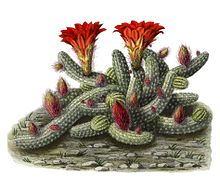Chamaecereus silvestrii
| Chamaecereus silvestrii | |
|---|---|

| |
| Scientific classification | |
| Kingdom: | Plantae |
| Clade: | Tracheophytes |
| Clade: | Angiosperms |
| Clade: | Eudicots |
| Order: | Caryophyllales |
| Family: | Cactaceae |
| Subfamily: | Cactoideae |
| Genus: | Chamaecereus |
| Species: | C. silvestrii
|
| Binomial name | |
| Chamaecereus silvestrii (Speg.) Britton & Rose[1]
| |
| Synonyms[1] | |
| |
Chamaecereus silvestrii is a species of cactus from northwestern Argentina and Bolivia. Synonyms include Echinopsis chamaecereus and Lobivia silvestrii.[1] It has been called the peanut cactus.[2] This plant should not be confused with Echinopsis silvestrii, a synonym of Echinopsis albispinosa, a species with a very different appearance.
Chamaecereus silvestrii has long stems about 1 cm (0.4 in) across. Orange flowers up to 4 cm (1.6 in) wide appear in late spring. In cultivation, Ch. silvestrii is hardy to temperatures as low as −7 °C (19 °F) if kept dry.[2]
Ch. silvestrii was first collected and described in 1896 as Cereus silvestrii by Italian-Argentinian botanist Carlo Luigi Spegazzini in the mountains between the provinces of Tucuman and Salta, Argentina.[3] However, subsequent expeditions to the area failed to find the species Spegazzini had collected and it is unknown whether the species has gone extinct since the initial collection.[4]
This plant is a recipient of the Royal Horticultural Society's Award of Garden Merit.[5]
-
Talcott Greenhouse
-
Flowers
References
[edit]- ^ a b c "Chamaecereus silvestrii (Speg.) Britton & Rose". Plants of the World Online. Royal Botanic Gardens, Kew. Retrieved 2023-09-28.
- ^ a b Anderson, Miles (1999), Cacti and Succulents : Illustrated Encyclopedia, Oxford: Sebastian Kelly, ISBN 978-1-84081-253-4, p. 67
- ^ Spegazzini, Carlo (1905). Cactacearum Plantensium Tentamen. Buenos Aires, Argentina: Juan A. Alsina. p. 51.
- ^ Lambert, Jacques G. (1992). Cactus d'Argentine. Concordia-Roeselare. p. 32.
- ^ "Echinopsis chamaecereus". www.rhs.org. Royal Horticultural Society. Retrieved 5 June 2020.
- Anderson, Edward F. (2001). The Cactus Family. Pentland, Oregon: Timber Press. p. 262. ISBN 978-0-88192-498-5.


